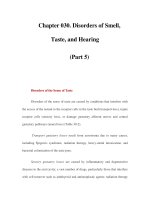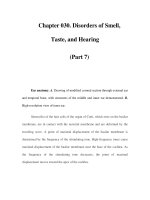Chapter 060. Enlargement of Lymph Nodes and Spleen (Part 4) docx
Bạn đang xem bản rút gọn của tài liệu. Xem và tải ngay bản đầy đủ của tài liệu tại đây (88.78 KB, 5 trang )
Chapter 060. Enlargement of Lymph
Nodes and Spleen
(Part 4)
Splenomegaly
Structure and Function of the Spleen
The spleen is a reticuloendothelial organ that has its embryologic origin in
the dorsal mesogastrium at about 5 weeks' gestation. It arises in a series of
hillocks, migrates to its normal adult location in the left upper quadrant (LUQ),
and is attached to the stomach via the gastrolienal ligament and to the kidney via
the lienorenal ligament. When the hillocks fail to unify into a single tissue mass,
accessory spleens may develop in around 20% of persons. The function of the
spleen has been elusive. Galen believed it was the source of "black bile" or
melancholia, and the word hypochondria (literally, beneath the ribs) and the idiom
"to vent one's spleen" attest to the beliefs that the spleen had an important
influence on the psyche and emotions. In humans its normal physiologic roles
seem to be the following:
1. Maintenance of quality control over erythrocytes in the red
pulp by removal of senescent and defective red blood cells. The spleen
accomplishes this function through a unique organization of its parenchyma
and vasculature (Fig. 60-1).
2. Synthesis of antibodies in the white pulp.
3. The removal of antibody-coated bacteria and antibody-coated
blood cells from the circulation.
Figure 60-1
Schematic spleen structure. The spleen comprises many units of red and
white pulp centered around small branches of the splenic artery, called central
arteries. White pulp is lymphoid in nature and contains B cell follicles, a marginal
zone around the follicles, and T cell–rich areas sheathing arterioles. The red pulp
areas include pulp sinuses and pulp cords. The cords are dead ends. In order to
regain access to the circulation, red blood cells must traverse tiny openings in the
sinusoidal lining. Stiff, damaged, or old red cells cannot enter the sinuses. (Top
portion of figure from CA Janeway et al: Immunobiology, 5th ed., New York,
Garland, 2001; bottom portion of figure from RS Hillman, KA Ault: Hematology
in Clinical Practice, 4th ed. New York, McGraw-Hill, 2005.)
An increase in these normal functions may result in splenomegaly.
The spleen is composed of red pulp and white pulp, which are Malpighi's
terms for the red blood–filled sinuses and reticuloendothelial cell–lined cords and
the white lymphoid follicles arrayed within the red pulp matrix. The spleen is in
the portal circulation. The reason for this is unknown but may relate to the fact that
lower blood pressure allows less rapid flow and minimizes damage to normal
erythrocytes. Blood flows into the spleen at a rate of about 150 mL/min through
the splenic artery, which ultimately ramifies into central arterioles. Some blood
goes from the arterioles to capillaries and then to splenic veins and out of the
spleen, but the majority of blood from central arterioles flows into the
macrophage-lined sinuses and cords. The blood entering the sinuses reenters the
circulation through the splenic venules, but the blood entering the cords is
subjected to an inspection of sorts. In order to return to the circulation, the blood
cells in the cords must squeeze through slits in the cord lining to enter the sinuses
that lead to the venules. Old and damaged erythrocytes are less deformable and are
retained in the cords, where they are destroyed and their components recycled.
Red cell inclusion bodies such as parasites (Chap. 203 and e18), nuclear residua
(Howell-Jolly bodies, Fig. 58-6), or denatured hemoglobin (Heinz bodies) are
pinched off in the process of passing through the slits, a process called pitting. The
culling of dead and damaged cells and the pitting of cells with inclusions appear to
occur without significant delay since the blood transit time through the spleen is
only slightly slower than in other organs.
The spleen is also capable of assisting the host in adapting to its hostile
environment. It has at least three adaptive functions: (1) clearance of bacteria and
particulates from the blood, (2) the generation of immune responses to certain
pathogens, and (3) the generation of cellular components of the blood under
circumstances in which the marrow is unable to meet the needs (i.e.,
extramedullary hematopoiesis). The latter adaptation is a recapitulation of the
blood-forming function the spleen plays during gestation. In some animals, the
spleen also serves a role in the vascular adaptation to stress because it stores red
blood cells (often hemoconcentrated to higher hematocrits than normal) under
normal circumstances and contracts under the influence of β-adrenergic
stimulation to provide the animal with an autotransfusion and improved oxygen-
carrying capacity. However, the normal human spleen does not sequester or store
red blood cells and does not contract in response to sympathetic stimuli. The
normal human spleen contains approximately one-third of the total body platelets
and a significant number of marginated neutrophils. These sequestered cells are
available when needed to respond to bleeding or infection.









